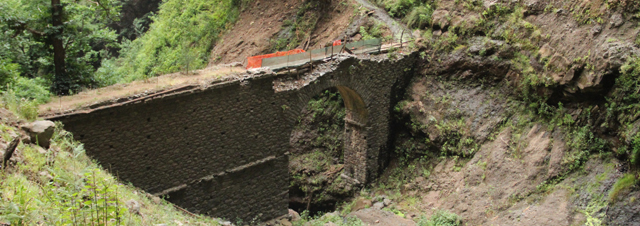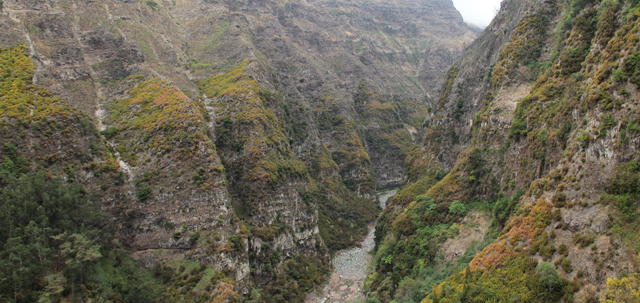Levada do Rei - Ribeiro Bonito
Vídeo/Video: http://www.youtube.com/watch?v=Srq5ZzXIHLo&hd=1
PT:
Bem Vindo à floresta de São Jorge!
Distância Total: 10.2 km
Altura máxima: 710m
Altura mínima: 530m
 O início deste percurso é junto à Estação de Tratamento de Águas nas Quebradas em São Jorge.
O início deste percurso é junto à Estação de Tratamento de Águas nas Quebradas em São Jorge.
Deixa o teu carro nas seguintes coordenadas:
N32º49.004, W16º55.484
De seguida deves subir as escadas para encontrar o início da levada (N32º48.922, W16º55.522).
A distância é de 5,1km (Total: 10,2km) numa levada bem cuidada e com protecções em várias zonas. Este passeio é magnífico. Todo o seu percurso é rodeado de bonitos fetos de variadas espécies e o seu chão tem uma cobertura de musgos, que dá uma beleza ímpar, e os tectos são das mais belas copas de loureiros, tis e vinháticos.
Pelo meio terás apenas um obstáculo:
 No final da levada chegarás ao Ribeiro Bonito. Aqui poderás te sentar para um pequeno lanche rodeado por um verde imenso e onde apenas se ouve o som da água do ribeiro que desce lentamente por entre as rochas.
No final da levada chegarás ao Ribeiro Bonito. Aqui poderás te sentar para um pequeno lanche rodeado por um verde imenso e onde apenas se ouve o som da água do ribeiro que desce lentamente por entre as rochas.
O Ribeiro Bonito, é um dos afluentes da grande Ribeira de São Jorge, que diga-se de passagem, é espectacular desde a sua cabeceira nas proximidades do Pico Ruivo, até à foz, encravada entre duas Achadas.
O Ribeiro Bonito é considerado um santuário natural devido à extrema beleza do local, coberto por vegetação que caracteriza uma das Florestas indígenas da Madeira, a mais densa e exuberante- a Floresta Laurissilva- atingindo o expoente máximo, pela sua localização, isolamento e abundância de água.
Sugestão: Alguns metros antes da madre da levada, sobe pelo discreto trilho à tua direita (ver foto) e sobe um pouco para usufruir de maior privacidade e de novas perspectivas para o Ribeiro Bonito.
O sinal GPS é geralmente fraco nesta área.

No regresso percorrerá o mesmo percurso podendo apreciar ainda mais calmamente as belezas da zona: a Ribeira de São Jorge com toda a sua rede de córregos e ribeiros; a povoação da Ilha; mais ao longe os lombos e achadas da freguesia de Santana; e finalmente o grande atlântico.
Ao finalizar o trilho não deixe de visitar o Moinho De Água de São Jorge (coordenadas) com cerca de três séculos de história, sendo um bom exemplo de preservação, alimentado com as águas da Levada do Rei, que faz moer o trigo, o milho, a cevada e o centeio, cultivados em poios agrícolas de São Jorge.
EN:
Welcome to the forest of "São Jorge"!
Total Distance: 10.2 km
Highest point: 710m
Lowest point: 530m
This route starts next to the Water Treatment Plant at Quebradas in São Jorge.
Park your car at the following coordinates: N32º49.004, W16º55.484
Then you must climb the stairs to find the levada (coordinates: N32º48.922, W16º55.522)
The distance is 5.1km (Total: 10,2km) in a well-kept levada with protections in several areas. This tour is magnificent. Your entire route is surrounded by beautiful ferns of various species and its floor has a moss cover, which gives it a unique beauty, and the ceilings are made of the most beautiful crowns of Madeira laurels (Ocotea foetens), the laurel trees (Laurus novocanariensis) and the Madeira mahogany (Persea indica).
Your biggest obstacle will be to pass under a small waterfall (see picture). Take a raincoat.
At the end of levada you will arrive to Ribeiro Bonito. Here you may sit down for a snack surrounded by an immense green while listening to the sound of the water descending slowly through the rocks.
Ribeiro Bonito is one of the tributaries of the large Ribeira de São Jorge, which is spectacular from its head near Pico Ruivo, to the mouth, stuck between two mountains.
Ribeiro Bonito is a true sanctuary of nature. This is one of the areas of the Laurisilva forest - World Nature Heritage of UNESCO since 1999, where the genuinely Madeiran vegetation reaches its highest expression and its location and isolation leave one with the sensation of having gone back in time to the discovery of the island.
Tip: Some meters before the end of the levada go up using the discrete track on your right (see picture) and climb up a bit to enjoy a greater privacy and new sights of Ribeiro Bonito.
GPS signal is generally weak in this area.
When returning you will travel the same route calmly enjoying the area's beauty: Ribeira de São Jorge with its entire network of streams and rivers; the population of Ilha; farther away the hills and valleys of Santana; and finally the great Atlantic Ocean.
Be sure to visit the São Jorge water mill (moínho), which is about three hundred years old. This mill is a good example of preservation, and powered by the water from the Levada do Rei, it grinds wheat, maize, barley and rye grown on the terraces of São Jorge.

GPS:
 O início deste percurso é junto à Estação de Tratamento de Águas nas Quebradas em São Jorge.
O início deste percurso é junto à Estação de Tratamento de Águas nas Quebradas em São Jorge.































































